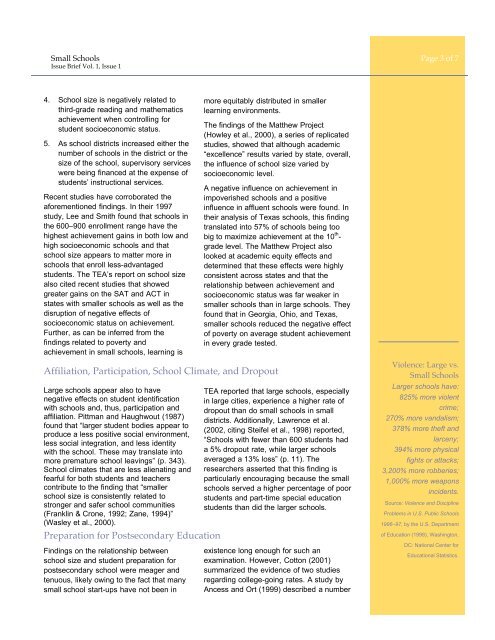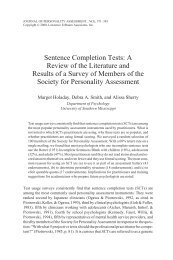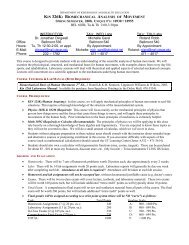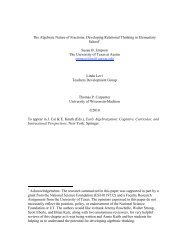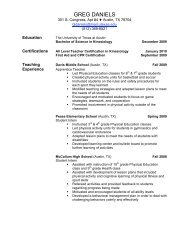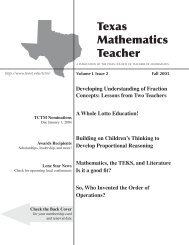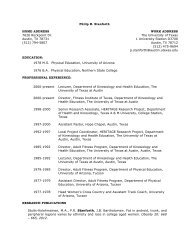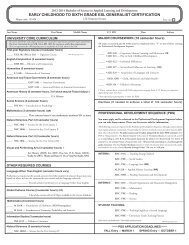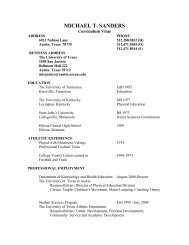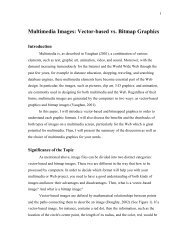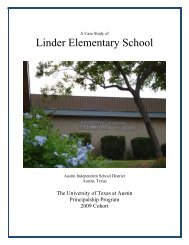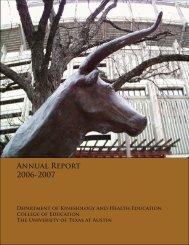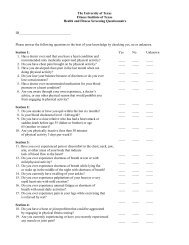High Schools: Size Does Matter - The College of Education - The ...
High Schools: Size Does Matter - The College of Education - The ...
High Schools: Size Does Matter - The College of Education - The ...
You also want an ePaper? Increase the reach of your titles
YUMPU automatically turns print PDFs into web optimized ePapers that Google loves.
Small <strong>Schools</strong> Page 3 <strong>of</strong> 7<br />
Issue Brief Vol. 1, Issue 1<br />
4. School size is negatively related to<br />
third-grade reading and mathematics<br />
achievement when controlling for<br />
student socioeconomic status.<br />
5. As school districts increased either the<br />
number <strong>of</strong> schools in the district or the<br />
size <strong>of</strong> the school, supervisory services<br />
were being financed at the expense <strong>of</strong><br />
students’ instructional services.<br />
Recent studies have corroborated the<br />
aforementioned findings. In their 1997<br />
study, Lee and Smith found that schools in<br />
the 600–900 enrollment range have the<br />
highest achievement gains in both low and<br />
high socioeconomic schools and that<br />
school size appears to matter more in<br />
schools that enroll less-advantaged<br />
students. <strong>The</strong> TEA’s report on school size<br />
also cited recent studies that showed<br />
greater gains on the SAT and ACT in<br />
states with smaller schools as well as the<br />
disruption <strong>of</strong> negative effects <strong>of</strong><br />
socioeconomic status on achievement.<br />
Further, as can be inferred from the<br />
findings related to poverty and<br />
achievement in small schools, learning is<br />
Affiliation, Participation, School Climate, and Dropout<br />
Large schools appear also to have<br />
negative effects on student identification<br />
with schools and, thus, participation and<br />
affiliation. Pittman and Haughwout (1987)<br />
found that “larger student bodies appear to<br />
produce a less positive social environment,<br />
less social integration, and less identity<br />
with the school. <strong>The</strong>se may translate into<br />
more premature school leavings” (p. 343).<br />
School climates that are less alienating and<br />
fearful for both students and teachers<br />
contribute to the finding that “smaller<br />
school size is consistently related to<br />
stronger and safer school communities<br />
(Franklin & Crone, 1992; Zane, 1994)”<br />
(Wasley et al., 2000).<br />
Preparation for Postsecondary <strong>Education</strong><br />
Findings on the relationship between<br />
school size and student preparation for<br />
postsecondary school were meager and<br />
tenuous, likely owing to the fact that many<br />
small school start-ups have not been in<br />
more equitably distributed in smaller<br />
learning environments.<br />
<strong>The</strong> findings <strong>of</strong> the Matthew Project<br />
(Howley et al., 2000), a series <strong>of</strong> replicated<br />
studies, showed that although academic<br />
“excellence” results varied by state, overall,<br />
the influence <strong>of</strong> school size varied by<br />
socioeconomic level.<br />
A negative influence on achievement in<br />
impoverished schools and a positive<br />
influence in affluent schools were found. In<br />
their analysis <strong>of</strong> Texas schools, this finding<br />
translated into 57% <strong>of</strong> schools being too<br />
big to maximize achievement at the 10 th -<br />
grade level. <strong>The</strong> Matthew Project also<br />
looked at academic equity effects and<br />
determined that these effects were highly<br />
consistent across states and that the<br />
relationship between achievement and<br />
socioeconomic status was far weaker in<br />
smaller schools than in large schools. <strong>The</strong>y<br />
found that in Georgia, Ohio, and Texas,<br />
smaller schools reduced the negative effect<br />
<strong>of</strong> poverty on average student achievement<br />
in every grade tested.<br />
TEA reported that large schools, especially<br />
in large cities, experience a higher rate <strong>of</strong><br />
dropout than do small schools in small<br />
districts. Additionally, Lawrence et al.<br />
(2002, citing Steifel et al., 1998) reported,<br />
“<strong>Schools</strong> with fewer than 600 students had<br />
a 5% dropout rate, while larger schools<br />
averaged a 13% loss” (p. 11). <strong>The</strong><br />
researchers asserted that this finding is<br />
particularly encouraging because the small<br />
schools served a higher percentage <strong>of</strong> poor<br />
students and part-time special education<br />
students than did the larger schools.<br />
existence long enough for such an<br />
examination. However, Cotton (2001)<br />
summarized the evidence <strong>of</strong> two studies<br />
regarding college-going rates. A study by<br />
Ancess and Ort (1999) described a number<br />
Violence: Large vs.<br />
Small <strong>Schools</strong><br />
Larger schools have:<br />
825% more violent<br />
crime;<br />
270% more vandalism;<br />
378% more theft and<br />
larceny;<br />
394% more physical<br />
fights or attacks;<br />
3,200% more robberies;<br />
1,000% more weapons<br />
incidents.<br />
Source: Violence and Discipline<br />
Problems in U.S. Public <strong>Schools</strong><br />
1996–97, by the U.S. Department<br />
<strong>of</strong> <strong>Education</strong> (1998), Washington,<br />
DC: National Center for<br />
<strong>Education</strong>al Statistics.


